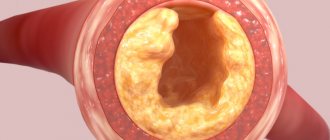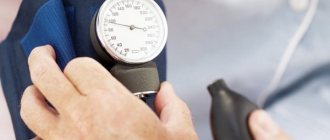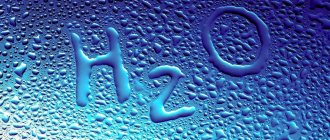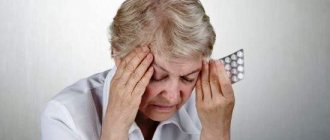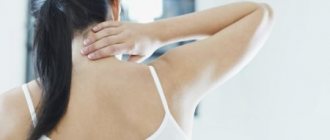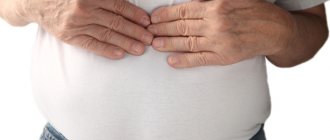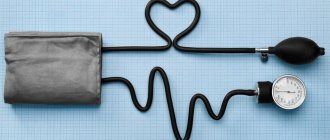Inflammation of hemorrhoids is an acute form of the disease, which is accompanied by severe pain and bleeding in the anus. Incorrect treatment or its complete absence can gradually lead to the development of thrombosis, requiring immediate surgical intervention. To prevent possible complications, it is important to know what to do in the situation that arises and how to prevent negative consequences.
What can cause hemorrhoidal bumps?
As we have already said, hemorrhoids are sac-like formations that form due to varicose veins in the anorectal area. But here it also needs to be said that, depending on the location of these bumps, there are three forms of hemorrhoids, namely:
- internal - when the bumps are located inside the rectal canal;
- external - when cones are formed from the saphenous veins located around the anus;
- combined - when the veins hypertrophy both inside the anal canal and around the anal ring.
The main reason why hemorrhoids may appear is stagnation of blood in the pelvic area, or more precisely in the vessels of the rectum and anal area. The venous vessels of the anorectal region become overfilled with blood, as a result of which their walls lose tone and become deformed over time.
Dystrophic changes in hemorrhoids are observed not only in the venous wall, but also in the muscles of the rectum. As a result of such changes in the muscles of the anal canal, hemorrhoidal cones can no longer be held inside the rectum and begin to fall out, and in advanced cases they lose the ability to be set back.
Weakening of the tone of the walls of the venous vessels of the anorectal region can be either congenital or develop under the influence of trigger factors. Most often, the following factors provoke venous insufficiency in the vessels of the rectum and anal area:
- “sedentary” lifestyle, when a person spends most of the day in a sitting position. Basically, this lifestyle is typical for such professions as driver, programmer, clerk, teacher, cashier or salesman;
- chronic constipation or diarrhea;
- excessive enthusiasm for diets or unbalanced nutrition, when the diet is poor in plant fiber;
- genetic predisposition, when close relatives also suffer from hemorrhoids or varicose veins of the lower extremities.
- bad habits, in particular alcohol abuse;
- physical labor associated with heavy lifting;
- oncological diseases of the pelvic organs;
- cirrhosis of the liver;
- heart and vascular diseases;
- pregnancy and childbirth.
All of these factors lead to stagnation of blood in the pelvic vessels. The risk of developing hemorrhoids increases significantly if the patient has several factors from this list.
What causes contribute to inflammation?
As mentioned above, the disease is characterized by a long course with periods of exacerbations. At some times it is asymptomatic (remission), but every patient must understand that the disease does not disappear without a trace and can worsen at any time. So, what causes hemorrhoids to become inflamed, and what exactly provokes them?
The reason for this lies in the fact that once dilated venous vessels are not able to return to their original shape. To some extent, patients themselves are to blame for the exacerbation of hemorrhoids: as soon as its intensity subsides, they stop following the diet and engage in heavy physical work.
As a result, the inflammatory process in hemorrhoids occurs unexpectedly and at the most inopportune moment. Based on this, we can come to the conclusion that the main reasons why hemorrhoids become inflamed are:
- Vascular diseases.
- Prolonged straining during bowel movements due to constipation.
- Sedentary (sedentary) lifestyle.
- Poor anal hygiene.
- Poor nutrition.
- Failure to comply with mandatory doctor's instructions.
Doctors strongly insist that in case of inflammation of hemorrhoids, do not self-medicate. Only classified medical consultation can help avoid aggravation of the patient's condition.
Hemorrhoids came out: symptoms
With internal hemorrhoids in the initial stages of the disease, the node is small in size and located inside the rectum, so in most cases they do not make themselves felt. But you still need to be attentive to your health and pay attention to the following symptoms:
- discomfort in the anal canal;
- feeling of incomplete bowel movement;
- itching in the anus, especially after bowel movements;
- minor painful sensations after visiting the toilet “in a big way”;
- the appearance of traces of blood on stool or toilet paper.
If left untreated, hemorrhoids become larger and the rectal muscles become overstretched. As a result of these processes, internal hemorrhoidal cones sag outward through the anal ring.
The above symptoms increase and become permanent. Constipation also becomes more frequent, since hypertrophied hemorrhoidal veins make it difficult for stool to move through the rectal canal.
External hemorrhoids are easy to identify from the first days of the disease, since you can independently see enlarged veins around the anus. With this form of hemorrhoidal process, the same symptoms will be present as with internal hemorrhoids.
With advanced hemorrhoids, the risk of complications increases significantly, including anal tears, pinching of hemorrhoidal cones, their thrombosis and necrosis. These complications are so painful that patients cannot move, sit or even lie down.
When hemorrhoidal cones are pinched in the anal ring, they become purple with a blue tint and swell. If therapeutic measures are not taken in time, necrosis of the strangulated tissue may develop.
DIAGNOSTICS
If a patient who comes to see a general practitioner presents complaints characteristic of hemorrhoids (discomfort, itching or burning sensation, a feeling of moisture in the anus, bleeding from the anus), the doctor is required to conduct a minimal proctological examination.
With the patient in the knee-elbow position, the anal area is examined, a digital examination of the rectum and anoscopy (examination using a special mirror) are performed.
External hemorrhoids are clearly identified by visual examination of the anus, internal ones - by anoscopy and digital examination.
Next, the patient is sent to a proctologist to clarify the diagnosis. A number of diseases have similar symptoms to hemorrhoids, including polyps and intestinal tumors. Therefore, the final diagnosis in proctological patients is made only after a detailed and multifaceted study.
The doctor may order the following tests:
- Digital examination is the main method for diagnosing proctological diseases. It is carried out in all cases of diseases of the rectum, regardless of their nature. This study makes it possible to quickly and without the use of expensive devices get a fairly accurate picture of the condition of the rectum.
- Sigmoidoscopy is the most common, accurate and reliable method for examining the rectum and lower sigmoid colon. Using a sigmoidoscope (it is a hollow tube up to 1 cm in diameter with an eyepiece at the end), you can examine the intestinal mucosa to a depth of 30-35 cm from the anus.
- Anoscopy is an examination of the anal canal and lower rectum using an anoscope (rectal speculum). The study is designed to examine the anal canal and rectum to a depth of 10-12 cm.
- Colonoscopy is a study during which the condition of the mucous membrane of the colon is visually assessed. It is performed with a special flexible device - an endoscope, which consists of many LEDs that transmit an image to a monitor.
- Irrigoscopy is an X-ray examination of the colon.
- Coprogram - analysis of stool for qualitative composition, i.e. for foreign inclusions, remnants of undigested food and mucus.
- A fecal occult blood test is performed to identify possible bleeding in the overlying parts of the intestine.
- A blood test is done to determine the presence or absence of anemia.
Is it possible to straighten a hemorrhoid on your own?
Hemorrhoidal cones begin to fall out in the second stage of hemorrhoids during bowel movements. After defecation, the nodes are independently retracted into the anal canal under the influence of the muscles of the anorectal region.
At the third stage of hemorrhoids, sagging of the hemorrhoids occurs not only during bowel movements, but also during physical activity, which increases the pressure inside the abdominal cavity. Coughing, sneezing, laughing, carrying a heavy object, deep squatting or passing gas can cause the cones to fall out.
If such a situation occurs and there is no way to contact a specialist, then you can try to return the hemorrhoidal cones inside the anal canal yourself, because the prolapsed node hurts a lot and can become dead.
When performing such a manipulation, you need to be extremely careful and careful, following the following instructions:
- wash your hands thoroughly with soap and treat with an antiseptic, such as medical alcohol;
- wear sterile latex gloves;
- to reduce pain, apply an antihemorrhoidal ointment with an anesthetic (Relief Ultra, Procto-Glivenol, Olestesin) or apply a compress with a cold decoction or chamomile infusion for 15-20 minutes;
- when the pain in the anus decreases, get on your knees, spreading them wide, and bend forward;
- lubricate the middle finger of the hand on the side of the fallen bump with Vaseline;
- With one hand, spread the buttocks, and with the middle finger of the other hand, gently and carefully push the fallen lump into the anus. When the hemorrhoid is in place, you will feel relief;
- after adjusting the knot, lie on your side, squeeze your buttocks and stay in this position for about 40 minutes.
Hemorrhoidal cones cannot be reduced if they are pinched in the anus, a blood clot has formed in them, or necrosis has developed.
If, after reduction, the hemorrhoid continues to hurt or falls back out, then these may be signs that the disease has already crossed the border of the fourth stage. In this case, self-medication is strictly prohibited. Only a specialist knows how to remove hemorrhoids without harming your health.
Anti-inflammatory suppositories
To the question of how to relieve inflammation of internal hemorrhoids, the answer is simple: rectal suppositories.
Modern antihemorrhoidal suppositories can not only relieve inflammation, but also dissolve blood clots, restore affected areas of the mucous membrane, reduce itching and burning, and relieve pain from hemorrhoids.
If the inflammation is severe and other negative symptoms are added, it is better to use combined rectal suppositories, for example, such as:
- Relief;
- Relief Ultra;
- Ultraproct;
- Hepatrombin G;
- Proctosedyl;
- Proctosan;
- Gepasolone for hemorrhoids, etc.
Of course, it is better to use anti-inflammatory suppositories after consulting a doctor, this rule especially applies to pregnant women and people with chronic diseases.
Hemorrhoids: how to treat?
Hemorrhoids can be cured only with the help of a whole range of therapeutic measures. To do this, experts use the following methods:
- diet therapy;
- use of conservative agents;
- surgical treatment of hemorrhoids.
In the initial stages of hemorrhoids, when hemorrhoidal cones do not yet fall out of the anus, treatment consists of following a diet and using anti-hemorrhoidal drugs, ointments, gels or suppositories. When the bumps begin to fall out, a specialist may recommend removing them using minimally invasive surgical techniques.
In advanced cases, conservative therapy is powerless, so the only radical method is hemorrhoidectomy.
Next, we propose to consider each component of the complex treatment of hemorrhoidal cones in more detail.
How to treat hemorrhoidal cones with diet?
Diet is one of the most important components of the complex treatment of hemorrhoids, since disruption of the intestines is one of the trigger factors for inflammation of hemorrhoidal cones.
Patients with hemorrhoids should adhere to the following dietary principles:
- eat regularly 5-6 times a day in small portions;
- It is strictly forbidden to go hungry;
- maintain sufficient water balance - at least 1.5 liters of clean water per day;
- the diet must necessarily include foods high in plant fiber (vegetables, fruits, cereals, herbs, 2 tablespoons of bran);
- do not forget about fermented milk products;
- Harmful foods and those that lead to constipation and flatulence are excluded from the diet: fried, smoked, spicy, salty and fatty foods, fatty meats, fish and poultry, white bread, pastries, sweets, pasta, hard cheese, white cabbage, radish, radish, sorrel, grapes;
- Strictly avoid drinking alcoholic beverages.
Prevention of pathology
What measures will best help prevent the inflammatory process? The main thing is the absence of hemorrhoids. After all, the disease develops into a real disease only in every fifth person.
This figure can be much lower if:
- adhere to the key principles of healthy eating;
- avoid constipation and diarrhea;
- give up excessive love of alcohol;
- When working for long periods of time sitting or standing, take regular breaks;
- if you have to lift weights, do only feasible work, without overexertion;
- After each bowel movement, wash with cool water;
- over the age of forty, periodically visit a proctologist.
If hemorrhoids have already been diagnosed, then the likelihood of inflammation of the nodes is much higher. But conscientious and responsible treatment allows the disease to avoid such complications.
THERE ARE CONTRAINDICATIONS CONSULTATION WITH YOUR DOCTOR IS REQUIRED
Author of the article Alexey Alexandrovich Egorov, proctologist
Write your opinion
Hemorrhoids: treatment with conservative means
Only the attending proctologist should select medications for hemorrhoids, since each drug has a strict list of indications and contraindications. Self-medication does not always give the expected result, and sometimes can cause side reactions that are dangerous to health and life.
In the fight against hemorrhoidal cones, both systemic and topical medications are prescribed.
Hemorrhoids can be treated using the following groups of drugs:
- venotonics . Drugs in this group help eliminate congestion in the rectal area by increasing the tone of the walls of the venous vessels. In this case, tablets such as Detralex, Venarus, Phlebodia 600, Aescusan and Venarus are highly effective;
- angioprotectors . The most effective drugs for hemorrhoids are Troxevasin, Vazonit and Pentoxifyline. These products strengthen the walls of the veins, improve microcirculation in the anorectal area and accelerate tissue restoration;
- non-hormonal anti-inflammatory drugs : Nimesil, Ibuprofen and Voltaren;
- laxatives _ The use of laxatives is indicated for chronic constipation, if it is not possible to normalize intestinal function through diet;
- antihemorrhoidal ointments and gels . The indication for the use of ointments and gels is external hemorrhoids. But most drugs come complete with an applicator that allows you to introduce an ointment or gel into the anal canal, so they can be used for internal localization of hemorrhoidal cones. The following ointments and gels are especially popular: Relief, Relief Advance, Relief Ultra, Procto-Glivenol, Posterisan, Hepatrombin, Troxevasin and Proctosedyl;
- antihemorrhoidal suppositories . Rectal suppositories are mainly used when hemorrhoids are located inside the rectum. Suppositories help reduce the intensity of hemorrhoid symptoms and also normalize blood circulation in the vessels of the anorectal area. Most often, experts prescribe the following rectal suppositories: Relief, Relief Advance, Relief Ultra, Procto-glivenol, Olestesin, Proctosedyl, Anuzol, Natalsid, Ultraproct and others.
A set of physical exercises at home for hemorrhoids
List of exercises that help with hemorrhoids:
- While lying on your back, move your stomach. Pull in first, then release quickly.
- Lie on your left side. Take a womb position - pull your knees to your chin, press your hand to the right hypochondrium. Move the stomach wall vigorously. Do the exercise on the right side. Exercise activates intestinal function.
- Take a position - lying on your back. Play the “bicycle” exercise.
- While lying on your back, press your stomach just below your navel. Intestinal function is stimulated.
Do not perform the listed exercises in the stage of exacerbation of hemorrhoids.
Hemorrhoids cause inconvenience to large masses of the population. Previously, the disease mostly affected older people. The disease is now affecting younger generations.
For treatment, you should resort to the installation of rectal suppositories for hemorrhoids with cracks. This effect of the active substance quickly reaches the target and produces a therapeutic effect faster than other means. To choose which suppositories are best to use, you need to know their types and when to use them.
How to remove hemorrhoids using minimally invasive techniques?
Recently, minimally invasive surgical methods have gained great popularity due to their effectiveness, low trauma, painlessness and short rehabilitation period.
Cones from hemorrhoids can be eliminated using the following methods:
- ligation (tying) of nodes with latex rings;
- destruction of cones with liquid nitrogen;
- sclerosis of hypertrophied hemorrhoidal veins;
- coagulation of cones with laser or infrared rays;
- disarterization (ligation of vessels that deliver blood to the cones).
Unfortunately, the listed methods are effective only in the initial stages of hemorrhoids. In the later stages of the disease or if the disease does not go away with conservative therapy, a radical operation is performed - hemorrhoidectomy.
How to cure hemorrhoids in the later stages?
At the third and fourth stages, the internal and external cones are completely removed along with part of the rectal mucosa, after which tissue plastic surgery is performed. This operation is called hemorrhoidectomy. There are many variations of this operation, but the essence is the same for all.
Hemorrhoidectomy is a large and painful operation that requires a long recovery period. Before surgery and at the postoperative stage, patients are also prescribed antihemorrhoidal drugs, which we described earlier.
How to treat hemorrhoids with folk remedies?
Traditional healers today can offer a whole arsenal of unconventional remedies, with the help of which, according to them, hemorrhoids can go away. But here you need to think clearly and understand that no matter how natural the folk remedy is, it is not effective enough to cope with hemorrhoidal cones. Therefore, if you decide to try this treatment, consult your doctor in advance.
There are the following traditional medicine methods for the treatment of hemorrhoids:
- microenemas with decoctions of medicinal plants (chamomile, yarrow, onion peel, oak bark, calendula and others), propolis extract, aloe juice, potato, beetroot, etc.
- baths. This procedure can also be carried out with infusions and decoctions of medicinal plants, cold water, a solution of potassium permanganate, mumiyo and other natural medicines;
- ointments, which consist of lard, butter, propolis, mumiyo, honey, juice of medicinal plants and root vegetables, tar and other natural ingredients;
- candles. Rectal suppositories are very easy to prepare at home. For this, raw potatoes are most often used. Ice candles, which are made from water, infusions and decoctions of medicinal plants, are also very popular;
- hirudotherapy is the use of medicinal leeches that take blood from hemorrhoidal cones and dissolve blood clots. This method should only be carried out by a specialist.
As a result, I would like to emphasize once again that a timely visit to a proctologist not only allows you to stop the progression of the disease, but is also a reliable prevention of its complications. Therefore, do not try to deal with hemorrhoidal cones on your own; leave this matter to a specialist.
Providing first aid during an inflammatory process
First aid for inflammation of hemorrhoids is a mandatory measure, since as a result of the formation of a wound, infection and general infection of the body can occur. Every person should know a number of specific actions that need to be taken if bleeding occurs in the anus:
- preparing a cold compress with a solution of potassium permanganate, as it disinfects damaged tissue well;
- providing the patient with the most comfortable position. It is strictly forbidden to be in a sitting position, as this can only aggravate acute signs of inflammation;
- cool baths with antiseptic solutions based on chamomile, calendula, celandine;
- use of quick-acting painkillers. Suppositories, ointments and tablets are used as effective medications;
- compliance with bed rest and relaxation of the intestinal system;
- the use of traditional medicine in the form of compresses, lotions and healing ointments.
After providing first aid, the patient must be shown to a doctor who will establish the correct diagnosis and prescribe appropriate treatment.

